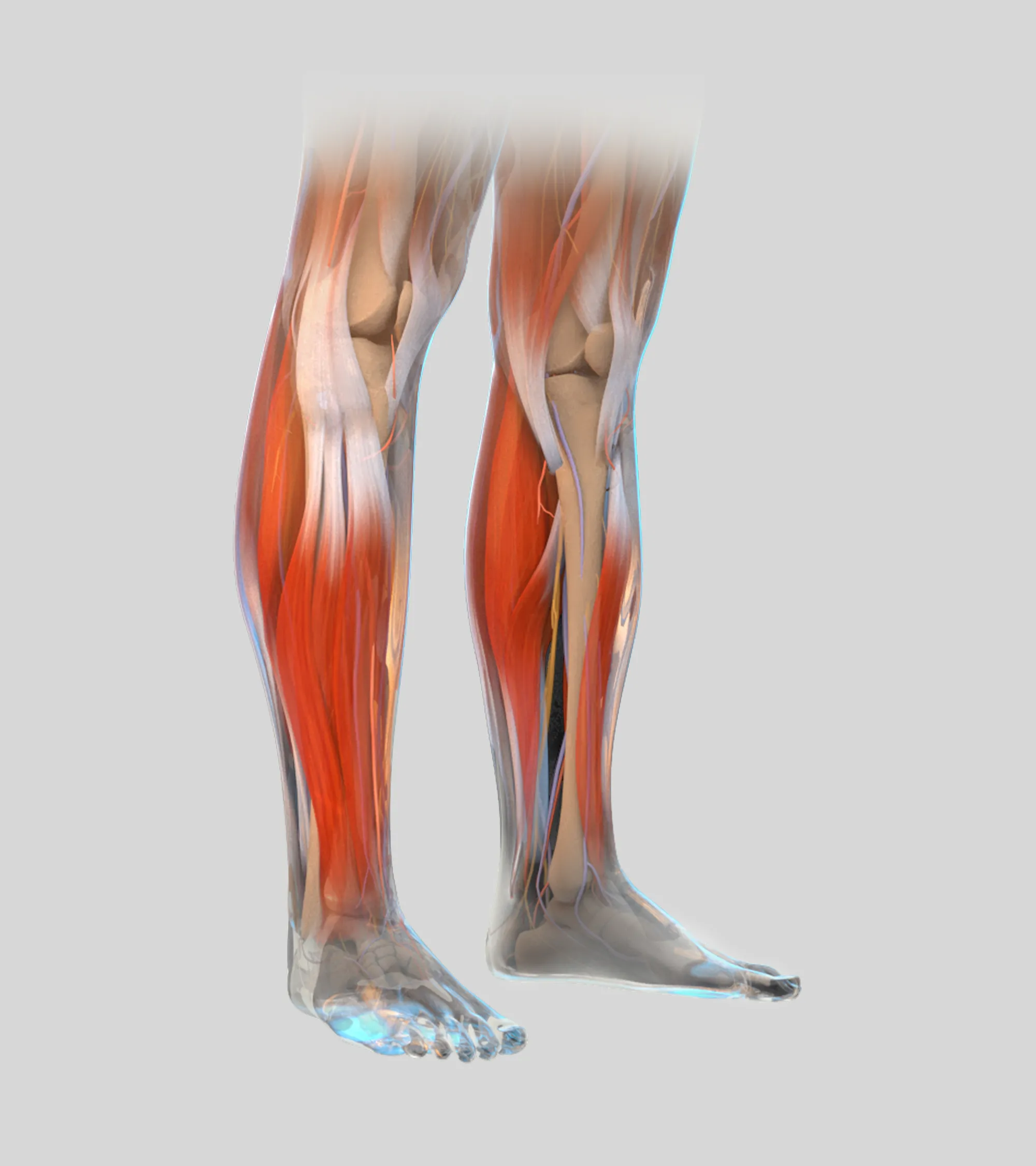
The Millar Mikro-Cath® records precise measurements within compartments of the body, typically in the upper and lower extremities, to monitor for compartment syndrome. The continuous, real-time data supports the diagnosis of acute compartment syndrome (ACS) or evaluation of chronic exertional compartment syndrome (CECS).
Mikro-Cath high-fidelity pressure measurements provide orthopedic trauma surgeons with reliable pressure signals to support and simplify the diagnosis of compartment syndrome for trauma patients. As a compartment pressure measurement device, the Mikro-Cath pressure catheter also supports orthopedic research and sports medicine physicians who monitor chronic exertional compartment syndrome and can be used in exercise studies due to the solid-state pressure sensor’s stability. This stability delivers reliable, accurate measurements even during patient movement.
With an appropriately sized introducer, the Mikro-Cath can be easily inserted into the targeted muscle compartment for continuous measurements up to 24 hours.
Mikro-Cath is a viable alternative to the previous Stryker compartment pressure monitor (now C2DX STIC intra-compartmental pressure monitor) and provides the advantage of continuous pressure monitoring, reliable signals and ease of use. With the catheter tip at only 3.5F (1.17 mm), the puncture wound is smaller than other catheter options. Patient movement also does not interfere with the signal quality compared to fluid-filled devices.
Acute compartment syndrome is considered a surgical emergency that, if not treated immediately, can lead to devastating disabilities, amputation or even death. Compartment syndrome is diagnosed when the interstitial pressure inside a muscle compartment is elevated to a point that exceeds capillary blood pressure. Resting pressures in healthy tissue are normally around 0–10 mmHg; pressures above 20 mmHg are considered elevated, and pressures where the differential from diastolic pressure is ≤ 30 mmHg for 2 or more hours are diagnostic of compartment syndrome.¹
The surgical treatment for compartment syndrome is typically a fasciotomy and is an effective treatment if a diagnosis can be made in a timely manner.²
Prior physical examination reveals pain in excess of what is to be expected that is provoked with stretching. Injuries may obscure pain perception, however, and pain management may mask the symptoms. If the patient is unconscious, it is vitally important to diagnose the development of compartment syndrome.
Timely application of a fasciotomy for treatment of compartment syndrome is critical.³ If properly diagnosed within 2 to 3 hours of its development, compartment syndrome can usually be alleviated and muscle tissue preserved through fasciotomy. Fasciotomy, however, can be associated with morbidity and should not be performed unless there is clear evidence of impending tissue damage from elevations in compartmental pressure. Therefore, correct diagnosis of compartment syndrome is important.
Unfortunately, accurate measurement of pressure within muscular compartments with currently available devices is complicated. The majority of devices currently available use a fluid-filled needle coupled to a remote pressure sensor, and as such the measurement needs to be performed under specific conditions. Prior to use, the equipment needs to be properly assembled and air bubbles flushed out of the fluid-filled needle. The device should be placed at the same angle that is to be inserted into the muscle and calibrated to zero.
During use, the patients need to be supine (fluid-filled lines to pressure sensors are susceptible to the effects of gravity), the correct amount of saline is to be injected into the area, and for repeated measurements, the catheter needs to be checked for patency and re-zeroed prior to taking the measurement. These requirements mean additional training needs to be undertaken by staff and extra time required during monitoring of each patient. Overall, the currently available technology has a range of shortfalls, which mean that surgeons often err on the side of diagnosing increased pressure and perform a fasciotomy rather than risk a false negative result with subsequent limb amputation.⁴
Recent studies indicate that compartment syndrome can develop slowly, over a 24-hour period, sometimes up to 48 to 72 hours after injury. Current clinical practice guidelines recommend assessment for clinical signs in alert patients, or to measure compartment pressure in unconscious patients or patients with impaired consciousness, every 4 hours for a minimum of 24 hours for suspected cases of compartment pressure syndrome.⁵,⁶ Some clinicians suggest more frequent monitoring of compartment pressure for early detection of a progressive development of compartment syndrome, monitoring every 30 minutes to 2 hours.
Millar Inc. has been at the forefront in the use of MEMS pressure sensor technology for 50 years. Ultraminiature sensors (down to 170 μm or 0.007 in) placed at the end of catheters provide highly accurate measurements of pressure. These have been used to monitor signals, such as intracranial pressure, pulmonary pressure, cardiac pressures and arterial pressure, in a wide variety of clinical applications from head trauma to cardiology. Now, these sensors and technology are available for the diagnosis of compartment syndrome.
The Millar Mikro-Cath Pressure Catheter has been used to assess chronic exertional compartment syndrome. Studies have demonstrated that these sensors work well to measure compartment pressure while subjects are supine as well as during treadmill exercise with a military backpack.⁷ The sensors are well-tolerated, and the flexible cable allows walking and running on a treadmill. The pressure sensor at the tip of the catheter and no fluid means no measurement artifacts and a quick, easy setup and collection of pressure.
According to a 2004 study, compartment syndrome diagnosis is one of the most common sources of litigation against orthopedic surgeons. The average cost of a settlement for undiagnosed compartment syndrome has been cited at $426,000.³ There is value in bringing higher confidence back into the equation.
Mikro-Cath offers improved sensitivity and specificity over existing methods in the diagnosis of anterior compartment CECS by obtaining continuous, high-fidelity data. Benefits include:
The Mikro-Cath Pressure Catheter delivers repeatable, exact data for reliable insight into cardiovascular, respiratory and intracompartmental pressure cases. The solid-state catheter is unaffected by motion artifacts or body position, providing data you can count on when making critical clinical decisions. Mikro-Cath also provides expert evaluation for benchtop studies when evaluating efficacy of medical device performance.

Download the Mikro-Cath Compartment Pressure Catheter information sheets to learn more about Millar’s market-leading solution for obtaining the most accurate and comprehensive pressure measurements.

Learn how sports physician Dr. Jaap Stomphorst uses Millar’s Mikro-Cath to revolutionize diagnostic methods for Chronic Exertional Compartment Syndrome (CECS) in athletes.
Discover how innovative catheter-based devices are changing the game in diagnosing Chronic Exertional Compartment Syndrome.
¹ Duckworth AD, McQueen MM. “Continuous intracompartmental pressure monitoring for acute compartment syndrome.” JBJS Essent Surg Tech. 3(3):e13 2014.
² Rorabeck, C. H. “The treatment of compartment syndromes of the leg.” The Journal of Bone and Joint Surgery. British volume 66, 93–97, 1984.
³ Olson, S. A. and Glasgow, R. R. “Acute compartment syndrome in lower extremity musculoskeletal trauma.” The Journal of the American Academy of Orthopaedic Surgeons 13, 436–444, 2005.
⁴ Boody, A. R. and Wongworawat, M. D. “Accuracy in the measurement of compartment pressures: a comparison of three commonly used devices.” J Bone Joint Surg Am 87, 2415–2422, 2005.
⁵ Wall, C. J. et al. “Clinical practice guidelines for the management of acute limb compartment syndrome following trauma.” ANZ Journal of Surgery 80, 151–156, 2010.
⁶ Kakagia, D. “How to Close a Limb Fasciotomy Wound: An Overview of Current Techniques.” The International Journal of Lower Extremity Wounds 14, 268–276, 2015.
⁷ Roscoe, D., Roberts, A. J. and Hulse, D. “Intramuscular Compartment Pressure Measurement in Chronic Exertional Compartment Syndrome.” The American Journal of Sports Medicine 43, 392–398, 2015.
